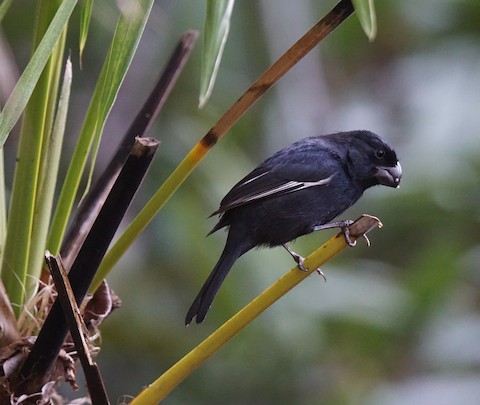Birdfinding.info ⇒ Most easily found at Botanic Park, where it is common. The Mastic Trail is also reliable. On the western side of the island, most recent reports have been around Barkers National Park, but apparently not regular there.
Grand Cayman Bullfinch
Melopyrrha taylori
Endemic to Grand Cayman, where it is resident in dry forest on the eastern side of the island and rare or sporadic on the western side.
In 2004, Hurricane Ivan caused a precipitous decline, but by 2020 its population had recovered to near pre-hurricane levels.
Identification
A large-billed bullfinch that is unique in its tiny range, but very similar to the closely related Cuban Bullfinch, which has traditionally been considered conspecific.
Male is jet-black with white wing patches on the shoulders and middle primaries.
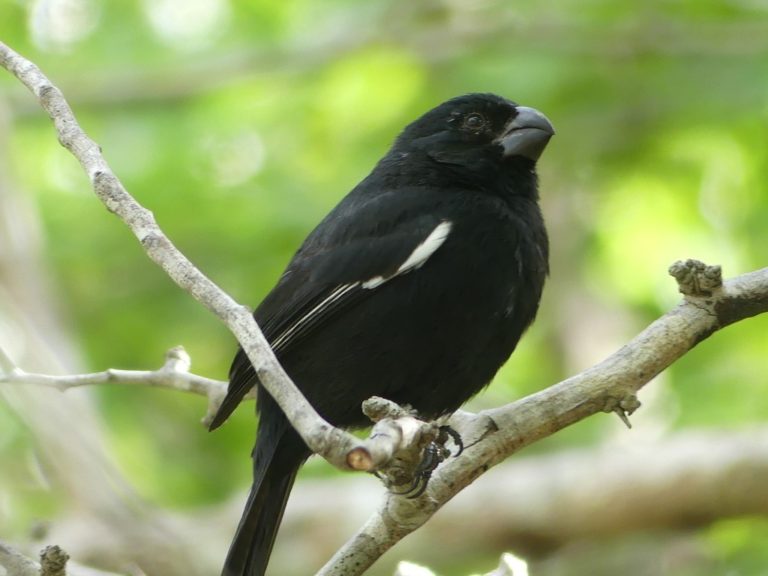
Grand Cayman Bullfinch, male. (Queen Elizabeth II Botanic Park, Grand Cayman; December 26, 2019.) © kg
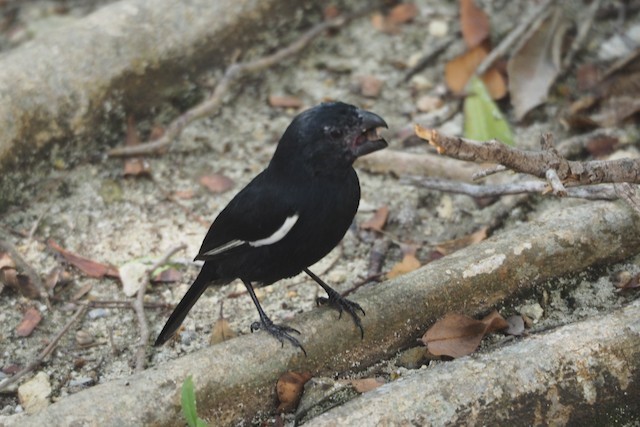
Grand Cayman Bullfinch, male. (Queen Elizabeth II Botanic Park, Grand Cayman; February 16, 2017.) © Colin Hill

Grand Cayman Bullfinch. (Brinkleys, Grand Cayman; July 27, 2012.) © Mark Rosenstein
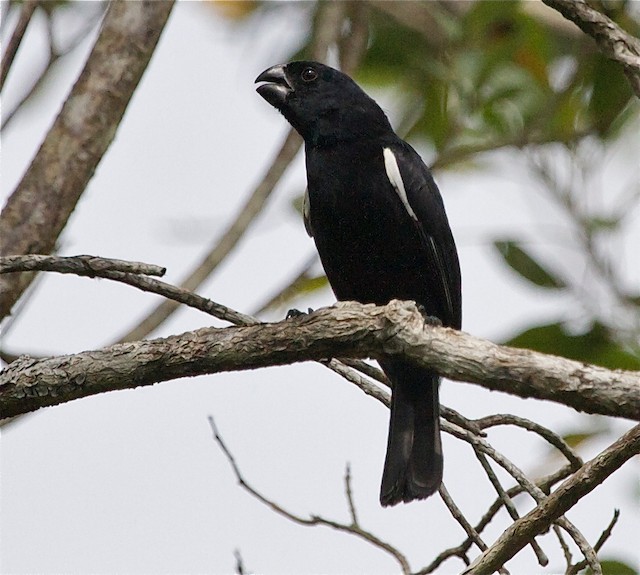
Grand Cayman Bullfinch, male. (Queen Elizabeth II Botanic Park, Grand Cayman; April 4, 2012.) © Karl Overman

Grand Cayman Bullfinch, male. (Queen Elizabeth II Botanic Park, Grand Cayman; October 15, 2018.) © Doug Gordon
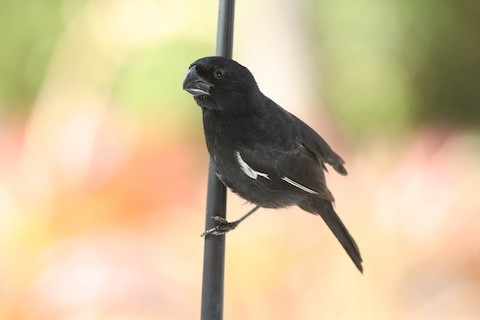
Grand Cayman Bullfinch, male. (Queen Elizabeth II Botanic Park, Grand Cayman; June 2, 2019.) © Knut Hansen
Grand Cayman’s bill averages 20-25% deeper (i.e., taller) at its base than Cuban Bullfinch’s, a significant structural difference and one of the principal indicators that the two forms are appropriately regarded as separate species.
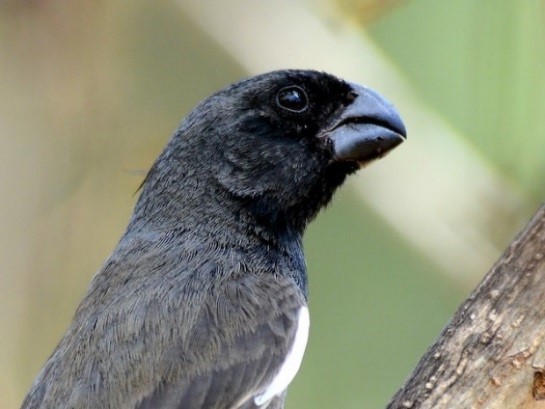
Grand Cayman Bullfinch, immature male, showing its deep-based bill. (Grand Cayman; March 19, 2013.) © Alan Van Norman

Grand Cayman Bullfinch, male, close view of its deep-based bill. (Queen Elizabeth II Botanic Park, Grand Cayman; March 24, 2016.) © Ceri James
Female has the same overall pattern as the male but is predominantly charcoal-gray instead of black, with olive-brown tones, especially on the back, wings, and tail.

Grand Cayman Bullfinch, female. (Mastic Trail, Grand Cayman; December 16, 2019.) © Nevine Jacob
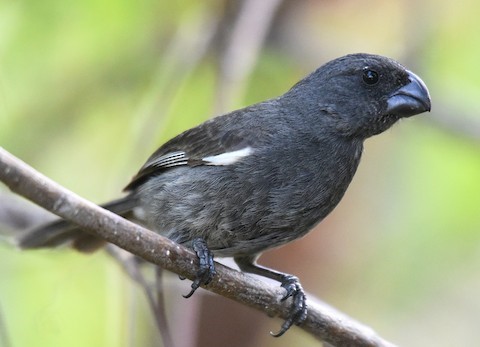
Grand Cayman Bullfinch, female. (Colliers Wilderness Reserve, Grand Cayman; April 2, 2019.) © Steven Mlodinow
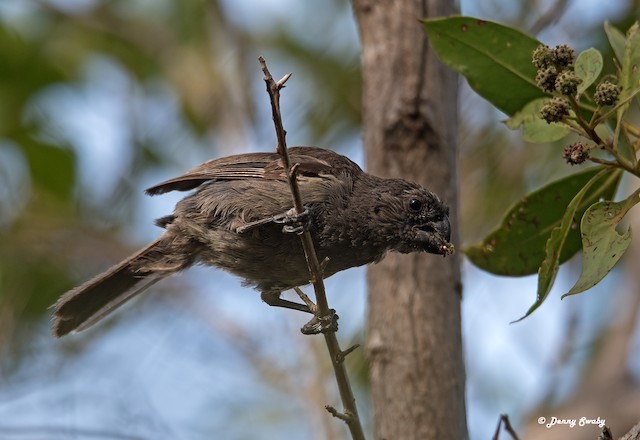
Grand Cayman Bullfinch, female. (Barkers National Park, Grand Cayman; August 31, 2017.) © Denny Swaby
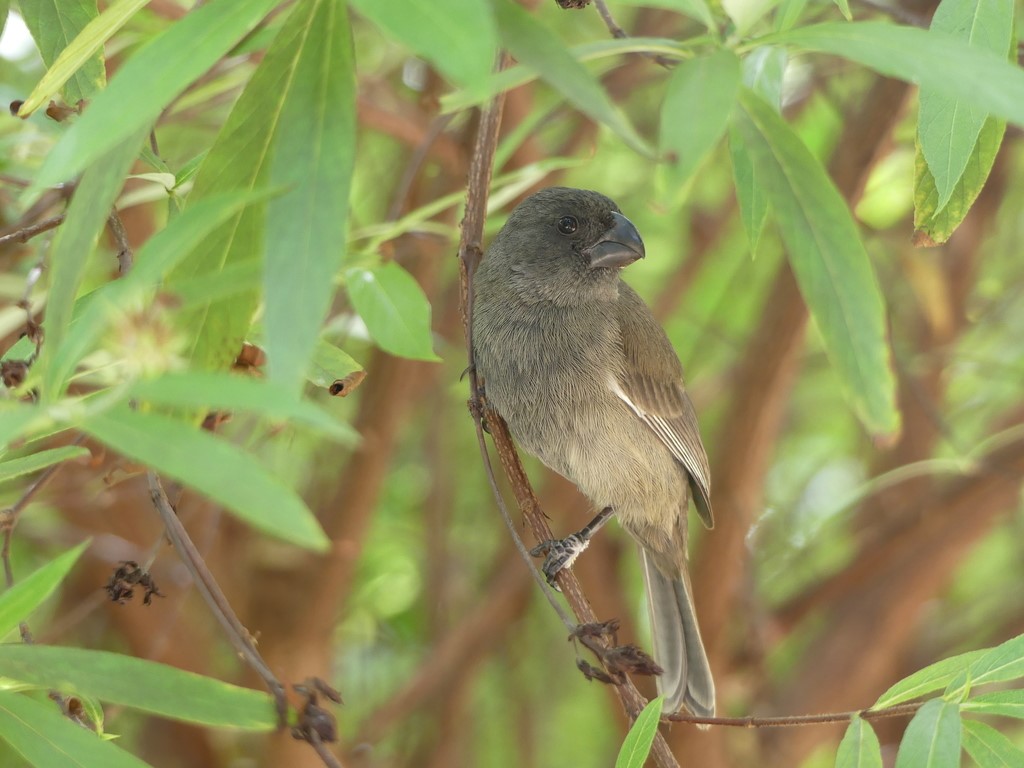
Grand Cayman Bullfinch, female. (Queen Elizabeth II Botanic Park, Grand Cayman; December 26, 2019.) © kg

Grand Cayman Bullfinch, female. (North Side, Grand Cayman; February 25, 2009.) © Jim Hoover
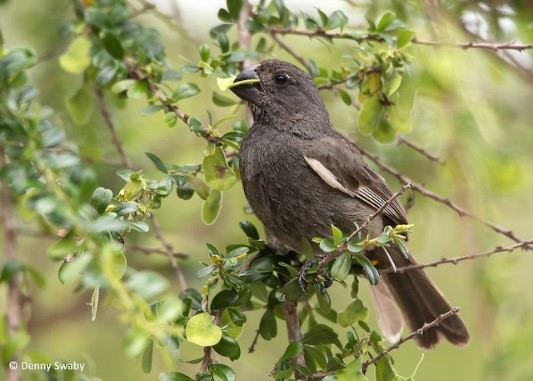
Grand Cayman Bullfinch, female. (Queen Elizabeth II Botanic Park, Grand Cayman; May 5, 2018.) © Denny Swaby
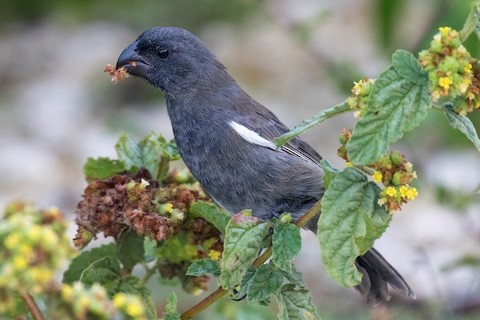
Grand Cayman Bullfinch, female. (Colliers Wilderness Reserve, Grand Cayman; November 21, 2015.) © Greg Bodker

Grand Cayman Bullfinch, female. (Colliers Wilderness Reserve, Grand Cayman; April 2, 2019.) © Steven Mlodinow
Immatures are like adults, but paler and more irregular in the tones of their plumage.
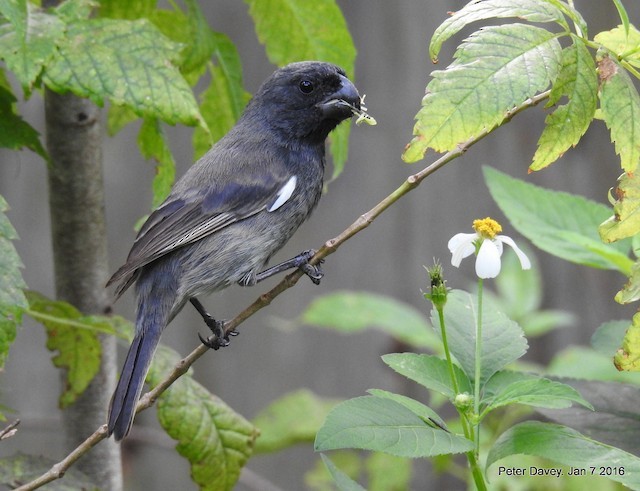
Grand Cayman Bullfinch, immature male. (Canaan Land Road, Grand Cayman; January 7, 2016.) © Peter Davey
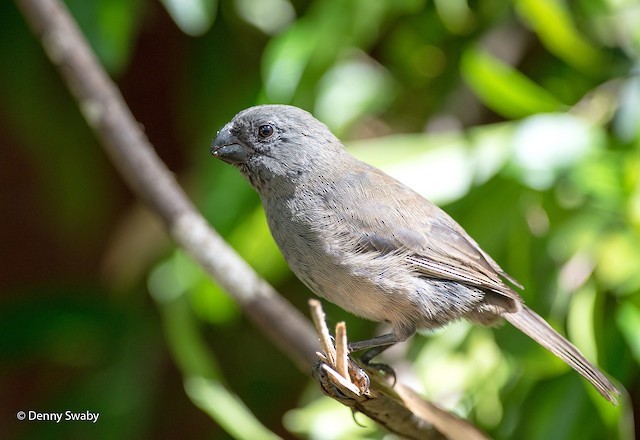
Grand Cayman Bullfinch, likely an immature female. (Arlington Private Estate, Grand Cayman; October 14, 2018.) © Denny Swaby
Voice. Song “begins as a trill zee-zee-zee, falls briefly then rises over 8–30 tssi notes, the longest reaching a very high and barely audible pitch” (Garrido et al. 2014): Calls are thin, high-pitched squeaks.
Cf. Cuban Bullfinch. Cuban and Grand Cayman Bullfinches are very similar and were traditionally considered a single species until Garrido et al. (2014) published a detailed analysis of the differences between them. They do not occur together naturally, so field identification based on geographical probability is usually sufficient. However, probability alone was inconclusive for a bullfinch that appeared on Little Cayman in 2018. Following are the principal differences between Cuban and Grand Cayman Bullfinches that Garrido et al. documented:
Size: Overall, the Grand Cayman Bullfinch averages larger than Cuban in six out of seven measurements studied. Its bill, in particular, is larger than the Cuban’s in every dimension, especially in its depth (i.e., height) at the base, where it averages about 20-25% larger.
Vocalizations: The songs of Cuban and Grand Cayman Bullfinches show consistent differences in pattern and complexity. Both begin with a trill and end with warbled phrases, but Cuban’s trill is longer and more rapid, and the ending phrases are more complex than Grand Cayman’s.
Coloration: There are also differences in the plumages of both sexes. Male Cubans have glossy-black plumage with a bluish or violet sheen, whereas male Grand Cayman Bullfinches are dull-black. Females differ more distinctively: Cubans are dull-black (like male Grand Cayman), whereas female Grand Caymans are charcoal-gray with olive-brown tones. On both sexes, Grand Caymans have white on two primaries, whereas Cubans typically have white on just one primary.
Notes
Monotypic species. Traditionally regarded as a subspecies of Cuban Bullfinch (nigra), but Garrido et al. (2014) show persuasive evidence that the two, although similar in most respects, are fundamentally different enough to be regarded as separate species. Their recommended split has been widely adopted.
IUCN Red List Status: Near Threatened.
References
BirdLife International. 2020. Pyrrhulagra taylori. The IUCN Red List of Threatened Species 2020: e.T103813133A180218485. https://dx.doi.org/10.2305/IUCN.UK.2020-3.RLTS.T103813133A180218485.en. (Accessed March 19, 2021.)
eBird. 2021. eBird: An online database of bird distribution and abundance. Cornell Lab of Ornithology, Ithaca, N.Y. http://www.ebird.org. (Accessed March 19, 2021.)
Garrido, O.H., J.W. Wiley, A. Kirkconnell, P.E. Bradley, A. Günther-Calhoun, and D. Rodríguez. 2014. Revision of the endemic West Indian genus Melopyrrha from Cuba and the Cayman Islands. Bulletin of the British Ornithological Club 134:134-144.
Kirwan, G.M., A. Levesque, M. Oberle, and C.J. Sharpe. 2019. Birds of the West Indies. Lynx Edicions, Barcelona.
Raffaele, H., J. Wiley, O. Garrido, A. Keith, and J. Raffaele. 1998. A Guide to the Birds of the West Indies. Princeton University Press, Princeton, N.J.
Xeno-Canto. 2021. Cuban Bullfinch – Melopyrrha nigra. https://www.xeno-canto.org/species/Melopyrrha-nigra. (Accessed March 19, 2021.)
